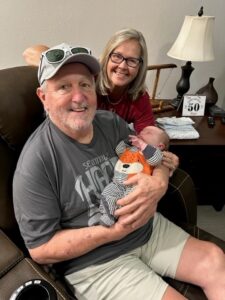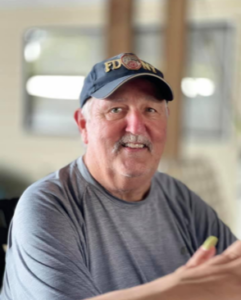‘Everything Got Better,’ after Coming to UAMS, says Leukemia Lymphoma Patient
| By the time Thomas Wages arrived at UAMS on February 15, 2022, he had been through one cancer diagnosis and 13 types of intensive chemotherapy. He was 70.
The active father of four was diagnosed with Chronic Lymphocytic Leukemia (CLL) in 2008, devastating news that came during one of the happiest times of his life. He had just met his future wife.
“It was love at first sight, and then B-A-M! He finds out he has leukemia,” said Jeanie Wages.
Thomas Wages knew something wasn’t right. It was unusual for the energetic golfer to feel tired.
“I was very shocked,” he said. “When you hear that word [cancer], you think, ‘dead man walking.’ It took me a long time to get over that feeling.”
For the next 14 years, the Little Rock man lived with debilitating fatigue from recurrent chemotherapy treatments that eventually forced him to retire and give up the active lifestyle he enjoyed.
CLL is a slow-growing type of leukemia common in adults that starts in the lymphocytes, the blood-forming cells of the bone marrow. Symptoms usually include fatigue, night sweats, fever, weight loss, infections, numbness and tingling, back pain, anemia and bone pain.
After 13 different chemotherapy treatments failed to put him in remission, Wages’ oncologist told him there were no other treatment options available.
“You just feel helpless and left out in the cold,” said Jeanie Wages.
Around the same time, she saw a story on the local news about a UAMS doctor offering a new cellular therapy for patients with acute leukemia and lymphoma. The doctor was Muthu Veera Kumaran, M.D., (formerly known as Muthu Veeraputhiran), a medical oncologist and clinical director of the Stem Cell Transplantation and Cellular Therapy Program at the UAMS Winthrop P. Rockefeller Cancer Institute. The program performs around 300 transplants each year for patients with high-risk leukemia, myeloma and lymphoma.
Wages booked an appointment with Kumaran, hoping for a transplant. He was in for good news and bad news.
Kumaran confirmed a secondary cancer diagnosis of Small Lymphocytic Leukemia (SLL), or low-grade lymphoma that commonly develops in patients with chronic leukemia. It’s actually possible for a person to have both cancers, either at the same time or one after the other.
“It is not unusual for one form of blood cancer to develop into another, sometimes more aggressive type of blood cancer,” said Kumaran. The two forms of cancer share similar symptoms but are difficult to respond to conventional treatment.
Now with two cancers attacking his body, Wages was at a physical and emotional breaking point.
“He was very weak and his lymph nodes were the size of grapefruits in his neck and under his arms,” said Kumaran. Enlarged lymph nodes are one of the most common symptoms of lymphoma.
But Kumaran was aware of recent treatment advances for patients with leukemia and lymphoma and came up with a two-pronged strategy to attack the low-grade chronic leukemia and the fast-growing transformed lymphoma. He prescribed a chemotherapy that Wages had not tried before — Copiktra, also called Duvelisib, a therapy that targets a certain step in the molecular pathway that prevents the cancer cells from proliferating.
He was simultaneously started on intravenous infusion of the monoclonal antibody, Rituxan, in combination with Polatuzumab, another monoclonal antibody loaded with a lymphoma toxin to attack the fast-growing lymphoma.

Thomas is grateful for the extra time advanced treatments have given him – time to spend with his wife, Jeanie, and their six children and nine grandchildren.
“We have access and expertise to cutting-edge therapies, both approved and in clinical trials, that can potentially prolong and cure these complex hematologic diseases,” said Kumaran.
“Everything got better then,” said Wages after being on the combination treatment. He gets an infusion every three weeks and takes another targeted chemotherapy in pill form. While he can’t be on the therapy indefinitely, he feels better, and it’s keeping the cancer under control.
“I’ve done really well on it,” said Wages, who has had few side effects from the treatment.
Worried that he wouldn’t be able to watch his family grow, the couple relishes time with their blended family of six daughters, nine grandchildren and two great-grandchildren.
“It’s been a journey, but he’s doing so well now,” said Jeanie Wages.

New treatments he received at UAMS have given Thomas the energy to enjoy his love of boating and fishing on Lake DeGray.
The Wages have learned to take life one day at a time. Thomas has beaten the 10-year life expectancy he was given when he was first diagnosed and has used that extra time to live life to the fullest, which includes lots of time on Lake DeGray, fishing and family.
“I feel like I’m overstaying my welcome anyway,” he said. “I’m really content. I’ve done a lot of things, and I’m happy with my life.”
Wages encourages other cancer patients to get a second opinion if they are told they have no more options.
“Don’t lose hope,” Wages added.
“Cancer medicine is advancing so rapidly. There is almost always a new treatment or therapy around the corner that may help patients control their disease, prolong survival and even cure them,” said Kumaran.
Pirtobrutinib is another new treatment for relapsed/refractory CLL that is pending approval by the U.S. Food and Drug Administration. Wages will also be a candidate for a new CAR T-cell clinical trial that will be available soon at UAMS that uses a patient’s own immune cells to attack cancer cells.

